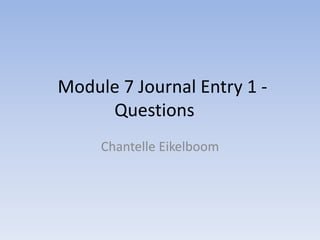
Module 7 questions
- 1. Module 7 Journal Entry 1 Questions Chantelle Eikelboom
- 2. Term Definition Inquiry and problem-based learning Approach that provides students with realistic problems that don’t necessarily have ‘right’ answers Cooperation Activity that focuses on group members working towards shared goals Collaboration Activity that involves group members in discussion, sharing different points of view, debate, constructive feedback and reaching consensus on issues
- 3. Describe the major elements of inquiry and problem-based learning. Describe how you could implement these ideas in planning a lesson in your subject area. How could you know that your efforts were successful? Problem based learning attempts to help students develop knowledge so they can understand complex concepts that can then be applied in many different situations. Other goals include enhancing problem solving skills, collaboration, evidence-based analysis and decision making (Hmelo-Silver, 2004, as cited in Educational Psychology, 2013, page 329). Students learn to work together with a problem as they find a solution. Students will analyse the problem, discuss it together, research for information and eventually come to a solution. Teachers are not only the source of knowledge, but now a guide for the students. They must assist students in their thinking and provide the needed scaffolding required for students to solve problems. Problem-based learning allows students to think for themselves and gives the opportunity for personal development and independent thinking. If I were a teacher, I would include this problem-based learning in my lessons. I would attempt to use problems that are real and that may directly effect the students, as well as problems that are interesting and informative. For example, if I were teaching children in Year 3, I might get my students to investigate weather patterns. They could research the different weather conditions and what causes these conditions. I would get them to work in small groups so they get the opportunity to share ideas and responsibilities. I can’t be 100% sure my efforts would be successful, but I am quite sure this would be an educational project for the children.
- 4. What is the role of teachers today in teaching thinking skills? Discuss your opinion with reference to the specific areas of creating a "culture of thinking" in classrooms and teaching critical thinking skills It may not be that difficult to teach children their times tables, but teaching students how to think may be a little more challenging. Woolfolk and Margetts (2013) claimed that the main characteristics of good thinkers include: Perseverance Achievement Flexibility Metacognition Creativity Responsibility Interdependence Communication Teachers must help students develop these characteristics and also develop thinking skills. Regarding ‘culture of thinking’, teachers must ensure that students not only possess the necessary thinking skills, but that they also know how use these abilities. Teachers must also make students thinking visible by asking questions and documentation. This way, teachers are able to help students by correcting their way of thinking if it is necessary.
- 5. What are some of the disadvantages of group learning? Group learning can be very beneficial as it teaches children to cooperate, work together and also teaches students about responsibility. However, it does have its disadvantages. Students may end up with different work loads. This happens if there are some lazy people in the group who don’t do their share. This results in some group members doing more work than others. Socialisation can also impact group learning. If a group contains several friends, there may be more socialising occurring rather than learning. For this reason, I think I would try avoid grouping friends if I were a teacher. However, I would still make sure each person would enjoy who they work with.
- 6. References Ritchhart, R., & Perkins, D (2005). Six Key Principles of the Cultures of Thinking Project. Retrieved from http://www.ronritchhart.com/COT_Resour ces_files/6Principles%20of%20COT_V2.pdf Woolfolk , A., & Margetts, K. (2013). Educational Psychology. NSW, Australia: Pearson